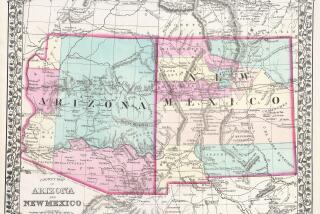The polarizing express
The online retailer Cafe Press, which allows users to sell their own products over the Internet, currently stocks 440,000 unique items relating to Hillary Clinton. Feeling the holiday spirit? You can purchase the “Hillary Is a Devil” Christmas ornament. If you’re more sartorially oriented, grab the “No Way in Hellary” shirt, tastefully emblazoned with a red sketch of Clinton flicking out her forked tongue. Or go in the opposite direction. An adjacent shirt on the page declares you a member of “Team Hillary,” complete with a membership logo etched in a calming, light-blue script. Polarization, it turns out, is good for business.
But is it good for Clinton? For Democrats, this is an immensely meaningful question. If the former first lady really is more polarizing than other candidates, if her negatives really are higher than theirs will ever be, if those voters who oppose her -- especially among independents and moderate Republicans -- truly oppose her fiercely and determinedly and immutably, then, well, that’s not a set of qualities you want in a nominee.
On the other hand, that may not be the case. After all, she starts with a high base of support (more registered voters say they will “definitely” support her in a general election than any other candidate, according to a USA Today/Gallup poll from November), and let’s face it, there’s really nothing left to throw at her. As her pollster, Mark Penn, said, “All her negatives are out.” She’s survived the process, is broadly known by voters and still wins most polled matchups against potential Republican challengers. So maybe she’s the safest bet.
It’s a tricky question. To determine whether she can really win the general election in November, you first have to figure out if she truly is more polarizing than her competitors. And, at least for the moment, the numbers suggest that she is. If you average the last five USA Today/Gallup polls, she has a 50.4% favorable rating and a 46.4% unfavorable rating. That’s a pretty even division. By contrast, Barack Obama has a 53.8% favorable rating and a 30.2% unfavorable number. Even the pugnacious Rudy Giuliani, who strikes me as about as likable as car trouble, exhibits negatives about 10% lower than Clinton’s.
Still, it’s a bit misleading to say “she” is more polarizing. Polarization isn’t a character trait; it’s the outcome of a process. And that process is American politics. Clinton was a central player in most of the high-profile political controversies between 1992 and 2000. Remember them all? The bruising healthcare reform fight of 1993 and 1994, the endless Whitewater scandal, the weird resuscitation of the ‘60s-era culture wars, the Lewinsky mess and all the rest. Fifteen years in the hothouse of national politics will leave you “polarizing” as surely as 15 minutes in a tanning bed will leave you bronzed.
To dramatize the point, Gallup recently released a set of numbers providing historical context to Clinton’s numbers. Before his successful 2004 reelection campaign, George W. Bush was viewed favorably by 52% of the populace and unfavorably by 47%. That means he was even more unpopular than Hillary Clinton is today -- yet he won. Worse yet, at the end of his 1992 election campaign, Bill Clinton was rated unfavorably by 49% of voters (thanks, in part, to Gennifer Flowers and allegations of draft dodging), and during his 1996 reelection campaign, 44% of voters said they had an unfavorable impression of him. Yet not only did he win both elections, he’s one of the most popular political figures in the country.
Those numbers tell a couple of different stories. The first is that it’s probably a mistake to compare Hillary Clinton with the other presidential hopefuls. Her many years as one of the most recognizable players in national politics leave her more comparable to a president running for reelection than a newcomer scrapping for a shot at the crown. As pollster Scott Rasmussen tells me, all the other candidates are going to see their negatives go up during the course of the campaign -- and if one of them ultimately wins the race, their negatives will go up even further. “The next president will get to where she is no matter who we elect,” he said. It’s not that the others are necessarily less polarizing than Clinton. It’s that they’re not as polarizing yet.
The other message of the Gallup numbers on Bill Clinton and George W. Bush is that voters can change. Hillary Clinton’s detractors like to argue that she can’t win because her negatives are hard rather than soft -- meaning that people have already made up their minds about her and are not movable on the subject. But history suggests that opinions are rarely set in stone. Between 1992 and 1996, for instance, Bill Clinton flipped from a net favorable rating (the percentage favorable minus the percentage unfavorable) of negative 7% to positive 11% -- that’s a shift of 18%, all of it upward. In November 2000, 60% of voters reported favorable feelings toward Bush, while a mere 34% disapproved. In November 2007, only 40% approve, while 55% can’t find a kind word -- a net shift of 41%, downward. True, those flips happened over significantly longer spans of time than a single campaign, but the point remains: Voters are rarely unwilling to change their minds.
Sadly, there’s no real way to predict whether attitudes toward Hillary Clinton will harden, lift or sink. The conclusion of most of the pollsters I spoke to was that she was both the Democrats’ safest candidate -- in the sense that her campaign was the least likely to implode, make foolish missteps or be rocked by unexpected revelations -- and simultaneously the least likely to preside over a transformative election or enter office with a massive mandate.
But none thought this was about Hillary Clinton, in particular. Sure, there were some people who were offended by her dismissive comments about “baking cookies” during the 1992 campaign, and some people who thought she should have been a more demure first lady, in the style of Laura Bush. But to focus on the polarizing powers of the individual is an error -- as Rasmussen says, and the numbers show, any individual, no matter how seemingly likable and innocuous, can mutate into a monster given sufficient visibility and an opposition with a healthy budget for negative advertisements.
The polarizing effects of the process are the larger truth that voters have to grapple with. How will Obama look after nine months of sinister insinuations about his heritage, religious loyalties and racial background? How will John Edwards look after the airwaves are blanketed with sneering ads focusing on his mansion and his record as a trial lawyer and his pricey haircuts? How will Mitt Romney come off after mocking videos of his bald shifts in position play during every commercial break?
This article should, I’m pretty sure, end with a ringing denunciation of polarization, of partisanship, of politics in general. But to reach for such simple conclusions is to dangerously oversimplify our national landscape. Insofar as real disagreements exist within the population, polarization is inevitable, even healthy. Disliking Edwards because you don’t think the government should create a universal health insurance program is perfectly legitimate. Fearing Giuliani because you prefer a president who won’t blow up the planet is, similarly, quite appropriate.
But those aren’t the most common drivers of polarization. Smears are. We saw it in 2004, with the vicious lies of the “Swift Boat Veterans for Truth.” We see it now, with untrackable e-mails warning that Obama is a secret Muslim who grew up attending fundamentalist madrasas (he isn’t and he didn’t). Repugnant as these tactics are, they’re also effective. Worse, they remain effective even when exposed as lies.
John Bullock, a political scientist at the University of British Columbia, has shown that when a smear is disproved, the voter will stop believing the smear but still hold a lower opinion of the candidate than would be true if they’d never been exposed to the lie. Negativity is negativity, and exposed to enough of it, an unsuspecting individual’s views are turned.
Given that dispiriting reality, the question becomes whether you can somehow negate the capacity of political professionals to polarize the electorate virtually at will. It’s an important question because, until an answer is found, there will be no such thing as a non-polarizing presidential candidate. There will only be those who aren’t polarizing yet. And that may be good for Cafe Press, but it’s probably not good for the country.
Ezra Klein is a staff writer at the American Prospect. His blog can be found at EzraKlein.com.
More to Read
Get the L.A. Times Politics newsletter
Deeply reported insights into legislation, politics and policy from Sacramento, Washington and beyond. In your inbox three times per week.
You may occasionally receive promotional content from the Los Angeles Times.






